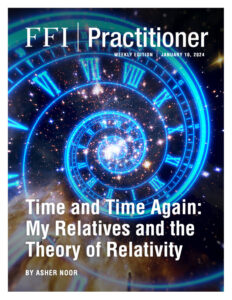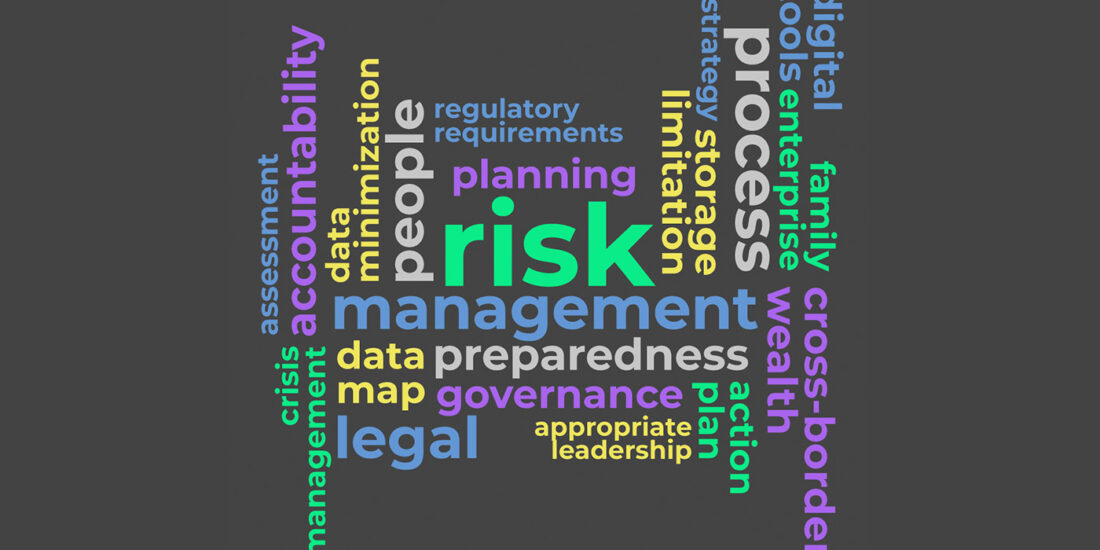
View this edition in our enhanced digital edition format with supporting visual insight and information.
The new year and the 2024 conference theme have happily conspired to make us think about time and timelessness in family enterprise advising and research. The deadline for proposals for the October conference is January 21, and we hope that these first four issues of 2024 will be inspiring and will spur your increased attention to the role that “Mean Time” plays in our field.
The first issue in this series is an essay by Asher Noor, in which he discusses scientific discoveries—and the lingering misconceptions—about the nature of time before considering how his relatives live out the elasticity of time in their own lives.
Introduction
In this article I will attempt to outline certain scientific truths about time. Then I will highlight the persistence of certain ingrained misconceptions about time, despite the presence of scientific evidence. Finally, I will share insights into how my relatives so ably grapple with the concept of time, despite apparent lack of awareness regarding the science of time.
The Science
Aristotle believed that earth was the center of the universe and the sun revolved around it. For 1,500 years, this incorrect scientific theory was widely accepted. Nicolaus Copernicus later proposed that earth circled the sun but did not make his theory public for almost three decades out of fear of persecution. Nearly half a century later, Giordano Bruno was burned at the stake for teaching this theory to his students. Three decades later, Galileo published his discoveries confirming earth orbited the sun. He paid the ultimate price for sharing this scientific truth and was promptly charged with heresy and put under house arrest, where he died serving the sentence. Suffice it to say, it took many lifetimes to lay the foundations of celestial timekeeping.
In the 20th century, Albert Einstein radically reimagined time with his theory of general relativity.1 He theorized that time is relative, meaning that the speed of the passage of time depends on the frame of reference of the observer. So, what is “now” to me, may not be “now” to another person—someone who is in relative motion different to mine. For example, if I am traveling on a spaceship and you are on earth, I will feel that the time is moving more slowly compared to you, given the speed of the spaceship. Accordingly, time can dilate (contract or stretch) based on the relative motion of the observers.
Einstein’s twin paradox2 suggests that if one twin goes out on a fast spaceship and the other stays behind on earth, the spacecraft-bound twin will experience time at a slower rate. When they reunite, the travelling twin will be younger than the one that stayed put on earth. This suggests that time is malleable.
Another aspect that Einstein’s theory of relativity introduced was the idea that massive objects like black holes and stars can bend time due to their gravitational pull. This means that clocks near massive objects will run slower than clocks in weaker gravitational pull areas. So, mass and energy in the universe can curve spacetime, affecting passage of time.
Time has indeed witnessed the fact that despite the 1931 publication of A Hundred Authors Against Einstein,3 his theories have now been proven by subsequent research and experiments—serving as a reminder that it takes time for scientific truths to go from being ridiculed, rejected, or repudiated to ultimately being accepted.
Shunning The Science
Regardless of where we live on the planet, we usually assume that everyone has the same exact twenty-four hours in a day. No more, no less. It’s a given that time is absolute. The scientific reality, however, begs to differ. The rate at which time passes depends entirely on the speed and acceleration of the person. Time slows down, however infinitesimally, as an object moves more quickly.
In other words, the faster we go, the more we are able to impact time passing—albeit on a much smaller scale than stars. Yet in our lives, we continue to hold onto the dogmas that time is immutable, absolute, and constant, even though science has proven that time is a variable, with motion and gravity having the power to bend or influence it.
My Timeless Relatives
In the safe sanctuary of shared time with my relatives, the reunions have a gravitational pull that transport us back through time. Through memory, time travel becomes a reality. The very fabric of time is disrupted, and we age backwards. This aging in reverse is due to the elixir of laughter, bonding, and energy all around. This subtle reversal of time is palpable.
Time moves more slowly, albeit in a good way, when my relatives band together. The more relatives are present at our family gatherings, the longer the happiness lasts and the more slowly time flows. Time stretches in the company of the elders surrounded by the youngsters, in a way that reminds me of time dilation around massive celestial objects. The elders—the giants of my family—pass down timeless wisdom, traditions, and culture over time.
Escaping the constraints of the past or the future, I also have relatives who simply live in the moment. Eternally present. Then, there are others who have leaned on time as a healing force, while some seem to be disconnected from the normal flow of time. What I have come to realize is that everyone has different interpretations of the same events, based on the frame of reference of the observer.
Conclusion
Family enterprise practitioners have a ringside seat to the lives of families they serve. The one fundamental truth is that circumstances change over time. There is a cyclical nature to time, just like the cycles of life itself.
What is important to understand is that the velocity of change—be it in scientific discoveries, technologies, or seasons—can prompt family enterprises to be in a constant race against time. Whether we let the speed of change create stress, we try to freeze the current moment so it might last for eternity, or we accept that time is relative, is solely up to us.
Now if only Einstein could shed light on why he undermined time by calling it an illusion.
References
1 A helpful summary of the theory of general relativity is the article Scott Dutfield, Nola Taylor Tillman, and Meghan Bartels, “What Is the Theory of General Relativity?” Space.com, last modified May 14, 2023, https://www.space.com/17661-theory-general-relativity.html.
2 Read more about Einstein’s twin paradox and time dilation in Ronald C. Lasky, “Time and the Twin Paradox,” Scientific American, February 1, 2006, https://www.space.com/17661-theory-general-relativity.html.
3 Hans Israel, Erich Ruckhaber, and Rudolf Weinman, eds., Hundert Autoren gegen Einstein. Leipzig: Voigtländer, 1931. https://archive.org/details/HundertAutorenGegenEinstein.

Asher Noor, FFI Fellow, is the founder and CEO of his private family office, Odyssey SFO, based in Melbourne, Australia. His expertise is in venture capital and private equity investing. He is the former chairman of the STEP SIG on Business Families and was on the editorial board of the STEP Journal. Asher is a former member of the FFI GEN faculty and was on the FFI Board of Directors from 2017 to 2021. He is a chartered accountant and received his MBA from EDHEC Business School. He can be contacted via www.ashernoor.com.

View this edition in our enhanced digital edition format with supporting visual insight and information.





